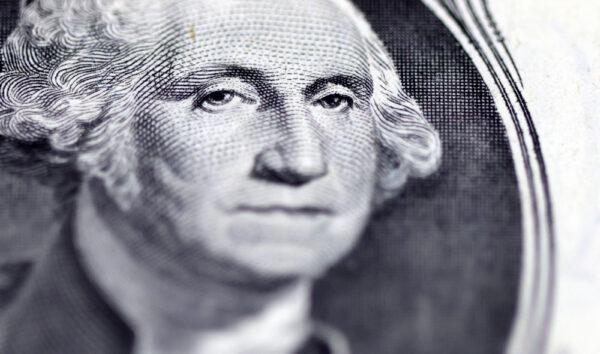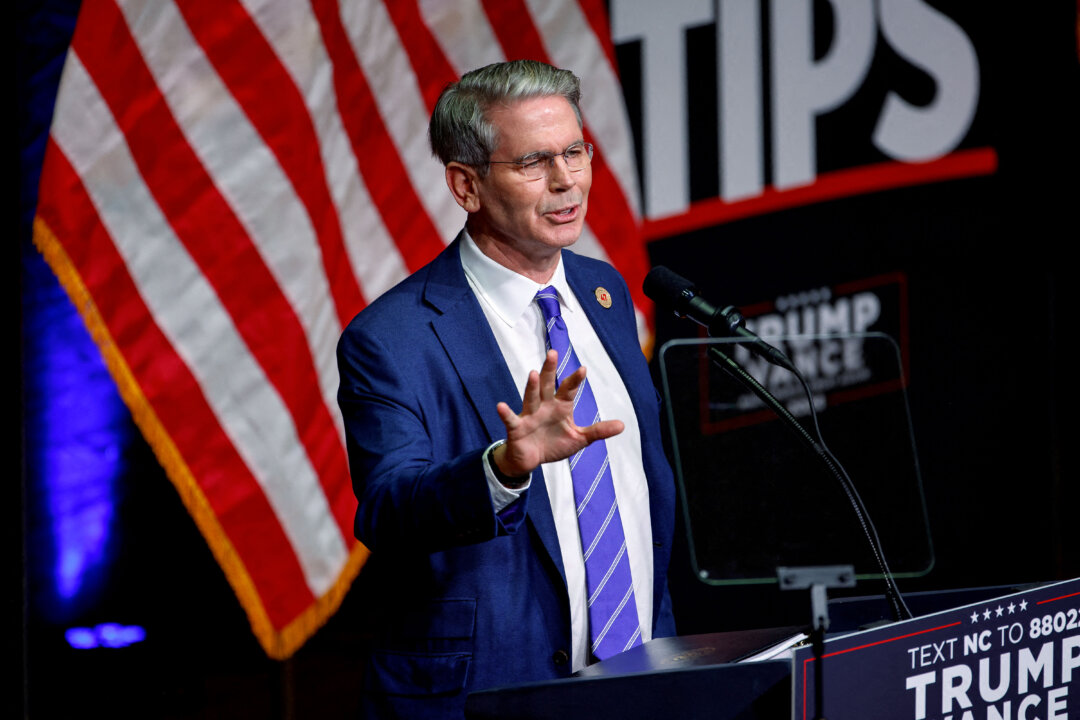Trump’s new Treasury secretary will be at the center of his economic agenda.
President-elect Donald Trump confirmed on Nov. 22 his plans to nominate Wall Street billionaire financier Scott Bessent as Treasury secretary.
Bessent, 62, founder of Key Square Group and Trump’s 2024 economic adviser, will serve in one of the most influential economic positions in the White House. By overseeing the Treasury Department, Bessent, if confirmed by the Senate, will function as the federal government’s fiscal watchdog and a vital administration official to enact the president-elect’s economic agenda.
“As a lifelong champion of Main Street America and American industry, Scott will support my policies that will drive U.S. competitiveness, and stop unfair trade imbalances, work to create an economy that places growth at the forefront, especially through our coming world energy dominance,” Trump said in an end-of-week announcement.
Bessent’s first job, if the matter isn’t resolved by Inauguration Day, might be to avert a default before the national debt ceiling agreement expires in January.
Fiscal Battle
The debt ceiling will be restarted on Jan. 1, 2025, after the current administration and GOP leadership reached a deal in June 2023. The Republican sweep might calm market fears of a prolonged debt ceiling standoff by speeding up an agreement.
When reinstated in January, the Treasury can take extraordinary measures until both sides reach an agreement, such as exhausting funds sitting at the Federal Reserve, suspending investments in government trusts, and reducing the amount of T-bill issuance.
At the same time, according to the Treasury General Account, the U.S. government maintains a sizable cash buffer, standing above $900 billion as of Nov. 21.
Last year’s debt ceiling showdown sparked panic on Wall Street, triggering a stock selloff and damaging the nation’s credit rating.
While Bessent has yet to address the upcoming debt-limit strife, he has advocated fiscal responsibility, concluding that Washington has a “spending problem” and the country needs to grow the economy to improve its finances.
“This is the last chance for America to grow its way out of its debt problem. If you can increase growth, you can change the trajectory,” he said in a September interview with CNBC’s “Squawk Box.”
Speaking at a Manhattan Institute event this past summer, Bessent touted a three-point economic proposal—an idea influenced by the late Japanese Prime Minister Shinzo Abe’s “three arrows” economic recovery initiative—that features a deficit reduction plan.
The seasoned hedge fund investor said he would push Trump to support efforts to lower the budget deficit to 3 percent of GDP by the end of his term.
“He didn’t get us to the 6 percent or 7 percent [of GDP] deficit. They averaged 4 [percent] under him, so get that down to 3 [percent],” Bessent said.
According to the Congressional Budget Office, the federal deficit currently equals 6.3 percent of GDP.
In a July op-ed for Fox News, Bessent stated that the United States’ debt is a national security threat.
He opined that the government’s tsunami of red ink threatens the country’s security by taking capital away from the private sector for private investment and imperiling U.S. standing in international financial markets.

“If you already have the pedal to [the] metal on spending and debt, you leave yourself no room to surge spending in case one or more of the current or simmering conflicts explodes, expands or metastasizes,” Bessent wrote.
The national debt recently exceeded $36 trillion for the first time, new Treasury data show.
Growth Agenda
Trade and tax policy will likely be major factors in Trump’s second-term economic agenda.
Bessent might hit the ground running in advocating for the president-elect’s tariff plans and extending the Tax Cuts and Jobs Act that expires later next year.
While the Treasury secretary does not impose tariffs or taxes, the senior position can influence the administration’s vision.
Bessent has been vocal in supporting tariffs and the Trump-era tax cuts, admitting that he can “nibble around the edges” of those portions of the agenda.
In a Fox Business interview, he said tariffs would be part of Trump’s growth agenda, likening them to a negotiating tool.
“Donald Trump has added a new leg to the Trump stool,” Bessent said.
At the same time, he has espoused a more conservative approach to instituting tariffs.
Bessent recently said to CNBC’s “Squawk Box” that tariffs should be “layered in gradually” to prevent higher prices from appearing immediately and to allow disinflationary efforts to offset them.
In The Economist in October, he stated that broad-based tariffs would be “more effective than microeconomic interventions like industrial policy that generally rely on the government to pick winners and losers.”
Speaking to the Financial Times in October, Bessent stated that Trump’s “maximalist” trade stances could be diminished amid deliberations with trading partners.
“My general view is that at the end of the day, he’s a free trader,” he said. “It’s escalate to de-escalate.”
My general view is that at the end of the day, he’s a free trader. It’s escalate to de-escalate.
— Bessent, President-elect Trump’s Treasury secretary nominee
In a Jan. 31 note to Key Square clients, Bessent noted that universal tariffs are unlikely to be implemented.
“The tariff gun will always be loaded and on the table but rarely discharged,” he wrote. “Of course, strategic and national security issues around China will remain.”
Trump has proposed a 10 percent to 20 percent across-the-board tariff and a 60 percent to 100 percent levy on all Chinese imports.
On the tax front, Bessent has dismissed the various estimates that Trump’s proposals would rekindle inflation and worsen debt and deficits.
“The good news is we have a roadmap for what Donald Trump did in Trump 1.0. It was not inflationary. The government revenues went up,” Bessent told Bloomberg Radio in October.

In addition to extending the tax cuts from his first term, the president-elect has proposed a series of targeted tax cuts, including the elimination of taxes on tips, exempting overtime pay from taxation, and removing taxes on Social Security benefits.
Dollar Dominance
Bessent said he believes that the new administration will endorse the three-decade-old strong-dollar policy, telling the Financial Times in October that Trump supports “the U.S. as a reserve currency.”
“The reserve currency can go up and down based on the market,” he said. “I believe that if you have good economic policies, you’re naturally going to have a strong dollar.”
His firm, meanwhile, presented a different take on the dollar.
Key Square’s note to investors suggested that Trump would explore a weak-dollar policy instead of installing tariffs.
“Tariffs are inflationary and would strengthen the dollar—hardly a good starting point for a U.S. industrial renaissance,” Bessent and the Key Square team wrote. “Weakening the dollar early in his second administration would make U.S. manufacturing competitive. A weak dollar and plentiful, cheap energy could power a boom.”
The U.S. dollar remains the chief international reserve currency. In addition to the greenback’s hegemony in the global financial market, it has strengthened immensely against many currencies worldwide since the COVID- 19 pandemic.
This year, the U.S. Dollar Index (DXY), a measure of the greenback against a weighted basket of currencies, has surged by 6 percent to a two-year high.
A stronger dollar presents a challenge for an incoming administration aiming to reinvigorate domestic manufacturing and bolster exports.
During Trump’s first term and throughout the 2024 election campaign trail, market watchers speculated that the Republican would embark upon a weak-dollar policy, reversing the White House’s long-standing position since the 1990s.
Then-Treasury Secretary Steven Mnuchin said at the World Economic Forum in 2018 that “a weaker dollar is good for us as it relates to trade and opportunities.”
“Longer term, the strength of the dollar is a reflection of the strength of the U.S. economy and the fact that it is and will continue to be the primary currency in terms of the reserve currency,” Mnuchin said.
Despite these assumptions, Trump has repeatedly clarified that the United States would keep the strong-dollar policy intact to prevent the country from slipping to “third-world status.”
“If a country tells me, ‘Sir, we like you very much, but we’re going to no longer adhere to being in the reserve currency, we’re not going to salute the dollar anymore.’ I’ll say, ‘That’s okay. And you’re going to pay a 100 percent tariff on everything you sell into the United States,’” Trump said at The Economic Club of Chicago in October.
Treasury Secretary Janet Yellen has espoused the U.S. dollar’s strength in world markets. While she has acknowledged the attempt by other countries to diversify, there is little realistic competition or alternative to the greenback.
Speaking at the annual meetings of the International Monetary Fund and World Bank in late October, Yellen expressed the importance of ensuring that the United States is the world’s primary reserve currency. This status, she said, is grounded in a solid macroeconomic performance, low inflation, and liquid capital markets.
“There really is no other currency I see as being a candidate in the near future to being able to replace the dollar,” Yellen told reporters.

